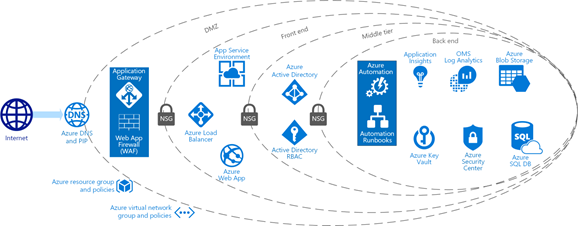Introduction to Microsoft Azure Architecture Styles
Today, the way applications are being designed, depends on how rapidly the cloud is evolving. Applications are now broken down into smaller and decentralized services instead of having them as monoliths. These services communicate through APIs or by using asynchronous messaging or eventing. Applications scale horizontally, adding new instances as demand requires.
These trends bring new challenges. Application state is distributed. Operations are done in parallel and asynchronously. The system as a whole must be resilient when failures occur. Deployments must be automated and predictable. Monitoring and telemetry are critical for gaining insight into the system.
| Traditional on-premises | Modern cloud |
| Monolithic, centralized Design for predictable scalability Relational database Strong consistency Serial and synchronized processing Design to avoid failures (MTBF) Occasional big updates Manual management Snowflake servers |
Decomposed, de-centralized Design for elastic scale Polyglot persistence (mix of storage technologies) Eventual consistency Parallel and asynchronous processing Design for failure (MTTR) Frequent small updates Automated self-management Immutable infrastructure |
Architecture styles
While designing an application, the very first decision that needs to be made is – the kind of architecture that needs to be built. It might be a microservices architecture, a more traditional N-tier application, or a big data solution. There are several distinct architecture styles. Each has its own pros and cons.
An architecture style is a family of architectures that share certain characteristics. For example, N-tier is a common architecture style. More recently, microservice architectures have started to gain favor. Architecture styles don’t require the use of particular technologies, but some technologies are well-suited for certain architectures. For example, containers are a natural fit for microservices.

- A description and logical diagram of the style.
- Recommendations for when to choose this style.
- Benefits, challenges, and best practices.
- A recommended deployment using relevant Azure services.
N-tier
N-tier is a traditional architecture for enterprise applications. Dependencies are managed by dividing the application into layers that perform logical functions, such as presentation, business logic, and data access. A layer can only call into layers that sit below it. However, this horizontal layering can be a liability. It can be hard to introduce changes in one part of the application without touching the rest of the application. That makes frequent updates a challenge, limiting how quickly new features can be added.
N-tier is a natural fit for migrating existing applications that already use a layered architecture. For that reason, N-tier is most often seen in infrastructure as a service (IaaS) solutions, or application that use a mix of IaaS and managed services.
Web-Queue-Worker
For a purely PaaS solution, consider a Web-Queue-Worker architecture. In this style, the application has a web front end that handles HTTP requests and a back-end worker that performs CPU-intensive tasks or long-running operations. The front end communicates to the worker through an asynchronous message queue.
Web-queue-worker is suitable for relatively simple domains with some resource-intensive tasks. Like N-tier, the architecture is easy to understand. The use of managed services simplifies deployment and operations. But with a complex domains, it can be hard to manage dependencies. The front end and the worker can easily become large, monolithic components that are hard to maintain and update. As with N-tier, this can reduce the frequency of updates and limit innovation.
Microservices
If your application has a more complex domain, consider moving to a Microservices architecture. A microservices application is composed of many small, independent services. Each service implements a single business capability. Services are loosely coupled, communicating through API contracts.
Each service can be built by a small, focused development team. Individual services can be deployed without a lot of coordination between teams, which encourages frequent updates. A microservice architecture is more complex to build and manage than either N-tier or web-queue-worker. It requires a mature development and DevOps culture. But done right, this style can lead to higher release velocity, faster innovation, and a more resilient architecture.
CQRS
The CQRS (Command and Query Responsibility Segregation) style separates read and write operations into separate models. This isolates the parts of the system that update data from the parts that read the data. Moreover, reads can be executed against a materialized view that is physically separate from the write database. That lets you scale the read and write workloads independently, and optimize the materialized view for queries.
CQRS makes the most sense when it’s applied to a subsystem of a larger architecture. Generally, you shouldn’t impose it across the entire application, as that will just create unneeded complexity. Consider it for collaborative domains where many users access the same data.
Event-driven architecture
Event-Driven Architectures use a publish-subscribe (pub-sub) model, where producers publish events, and consumers subscribe to them. The producers are independent from the consumers, and consumers are independent from each other.
Consider an event-driven architecture for applications that ingest and process a large volume of data with very low latency, such as IoT solutions. The style is also useful when different subsystems must perform different types of processing on the same event data.
Big Data, Big Compute
Big Data and Big Compute are specialized architecture styles for workloads that fit certain specific profiles. Big data divides a very large dataset into chunks, performing paralleling processing across the entire set, for analysis and reporting. Big compute, also called high-performance computing (HPC), makes parallel computations across a large number (thousands) of cores. Domains include simulations, modeling, and 3-D rendering.
Architecture styles as constraints
An architecture style places constraints on the design, including the set of elements that can appear and the allowed relationships between those elements. Constraints guide the “shape” of an architecture by restricting the universe of choices. When an architecture conforms to the constraints of a particular style, certain desirable properties emerge.
For example, the constraints in microservices include:
- A service represents a single responsibility.
- Every service is independent of the others.
- Data is private to the service that owns it. Services do not share data.
By adhering to these constraints, what emerges is a system where services can be deployed independently, faults are isolated, frequent updates are possible, and it’s easy to introduce new technologies into the application.
Before choosing an architecture style, make sure that you understand the underlying principles and constraints of that style. Otherwise, you can end up with a design that conforms to the style at a superficial level, but does not achieve the full potential of that style. It’s also important to be pragmatic. Sometimes it’s better to relax a constraint, rather than insist on architectural purity.
The following table summarizes how each style manages dependencies, and the types of domain that are best suited for each:
| Architecture style | Dependency management | Domain type |
| N-tier | Horizontal tiers divided by subnet | Traditional business domain. Frequency of updates is low. |
| Web-Queue-Worker | Front and backend jobs, decoupled by async messaging. | Relatively simple domain with some resource intensive tasks. |
| Microservices | Vertically (functionally) decomposed services that call each other through APIs. | Complicated domain. Frequent updates. |
| CQRS | Read/write segregation. Schema and scale are optimized separately. | Collaborative domain where lots of users access the same data. |
| Event-driven architecture. | Producer/consumer. Independent view per sub-system. | IoT and real-time systems |
| Big data | Divide a huge dataset into small chunks. Parallel processing on local datasets. | Batch and real-time data analysis. Predictive analysis using ML. |
| Big compute | Data allocation to thousands of cores. | Compute intensive domains such as simulation. |
Consider challenges and benefits
Constraints also create challenges, so it’s important to understand the trade-offs when adopting any of these styles. Do the benefits of the architecture style outweigh the challenges, for this subdomain and bounded context.
Here are some of the types of challenges to consider when selecting an architecture style:
Complexity: Is the complexity of the architecture justified for your domain? Conversely, is the style too simplistic for your domain? In that case, you risk ending up with a “ball of mud”, because the architecture does not help you to manage dependencies cleanly.
Asynchronous messaging and eventual consistency: Asynchronous messaging can be used to decouple services, and increase reliability (because messages can be retried) and scalability. However, this also creates challenges such as always-once semantics and eventual consistency.
Inter-service communication: As you decompose an application into separate services, there is a risk that communication between services will cause unacceptable latency or create network congestion (for example, in a microservices architecture).
Manageability: How hard is it to manage the application, monitor, deploy updates, and so on?




